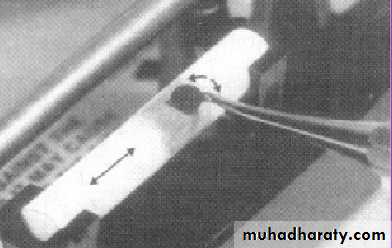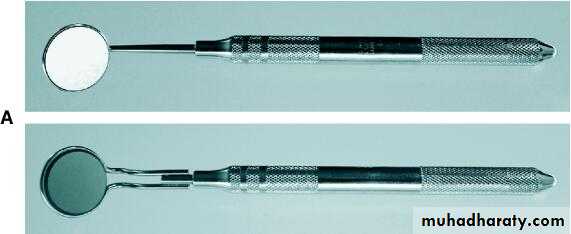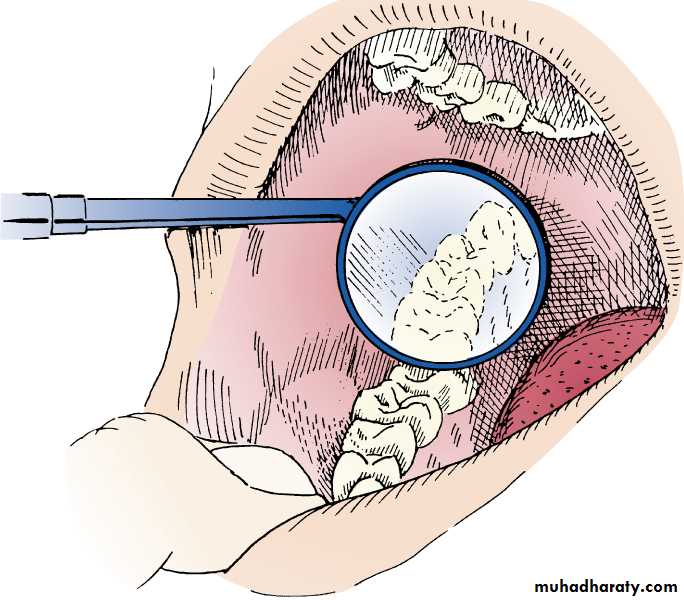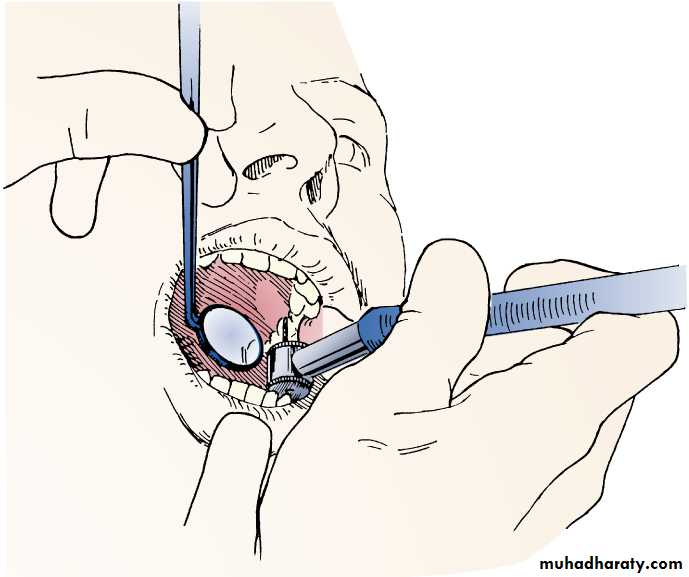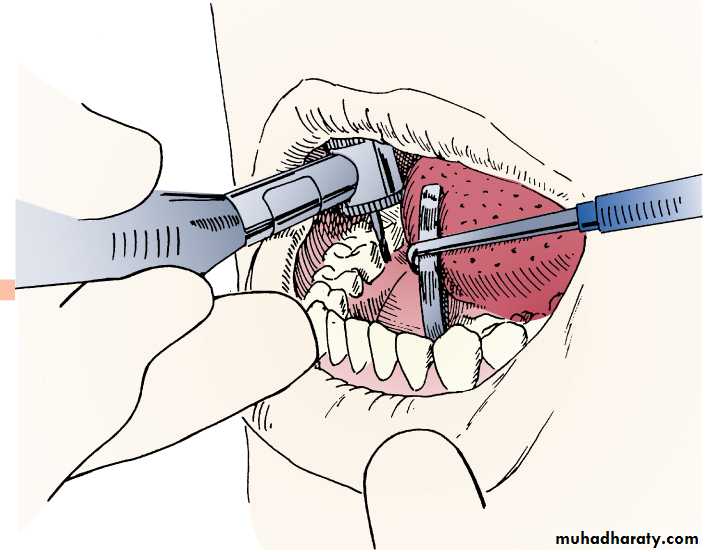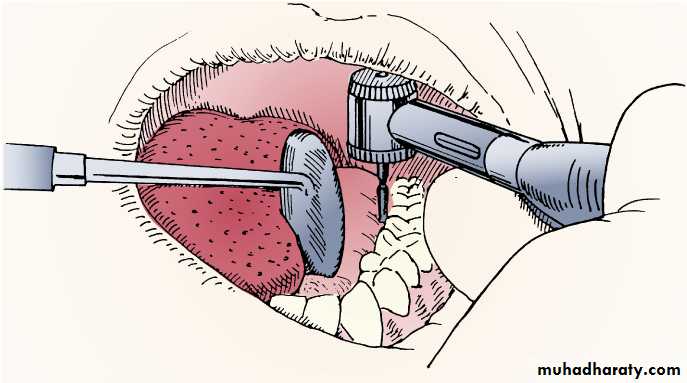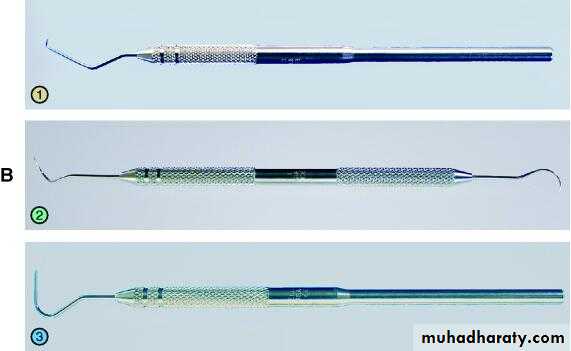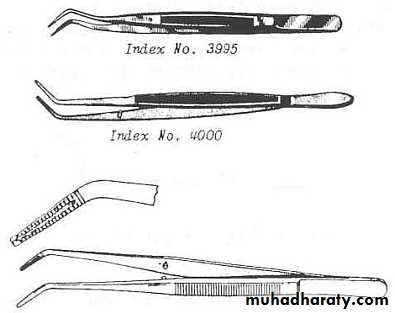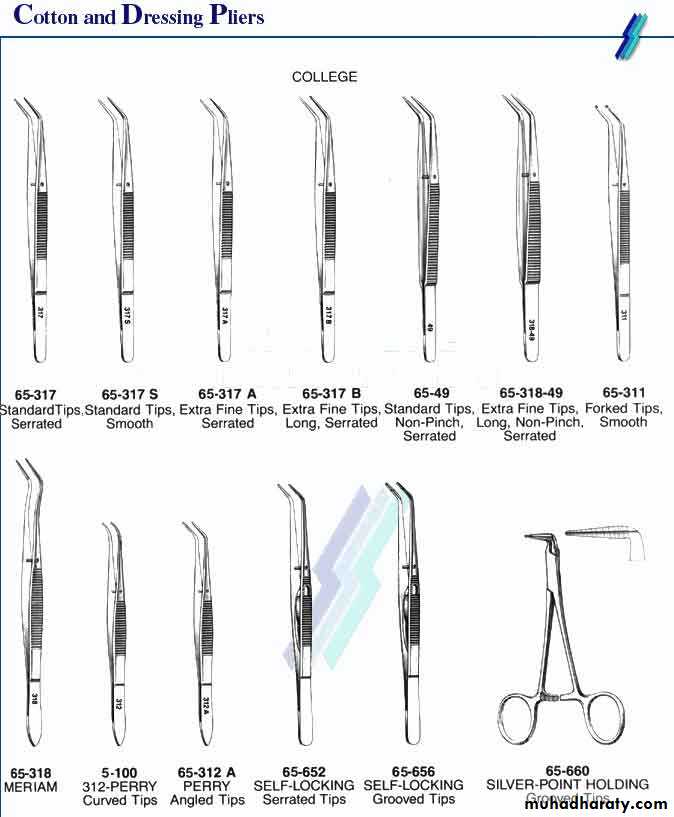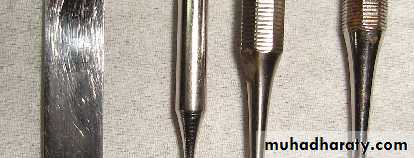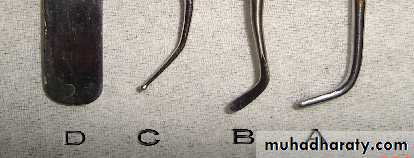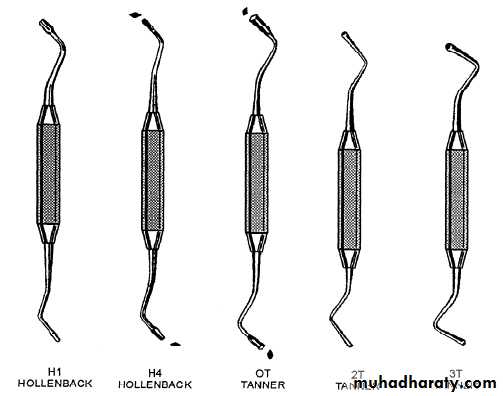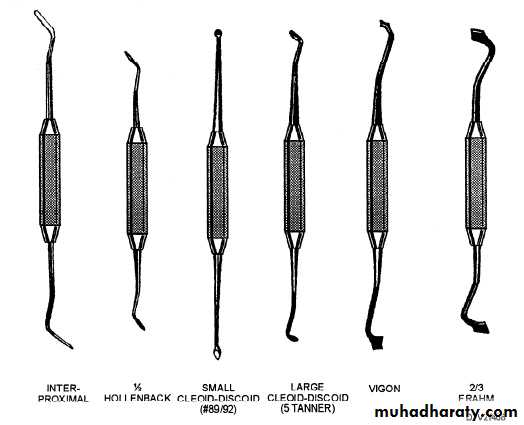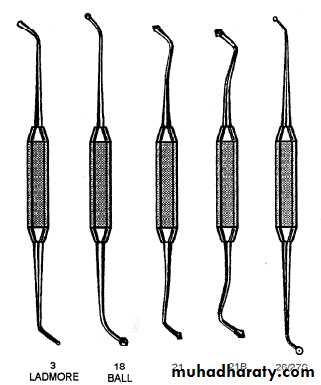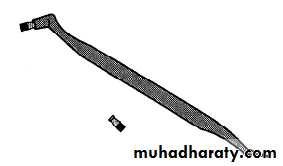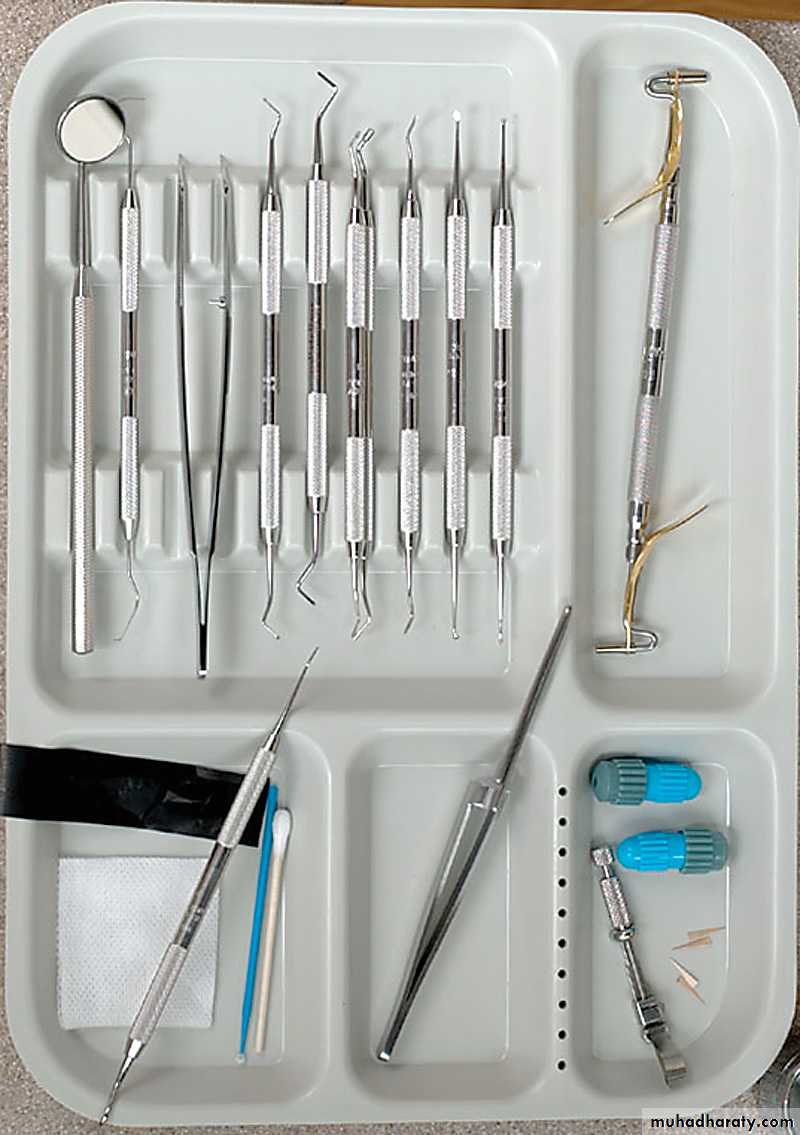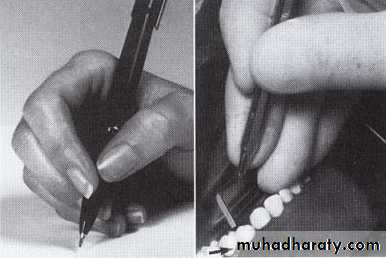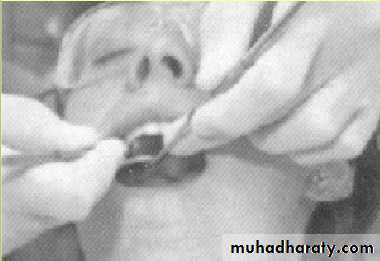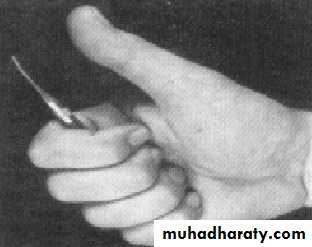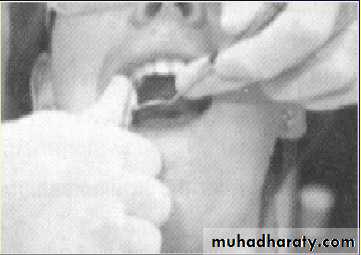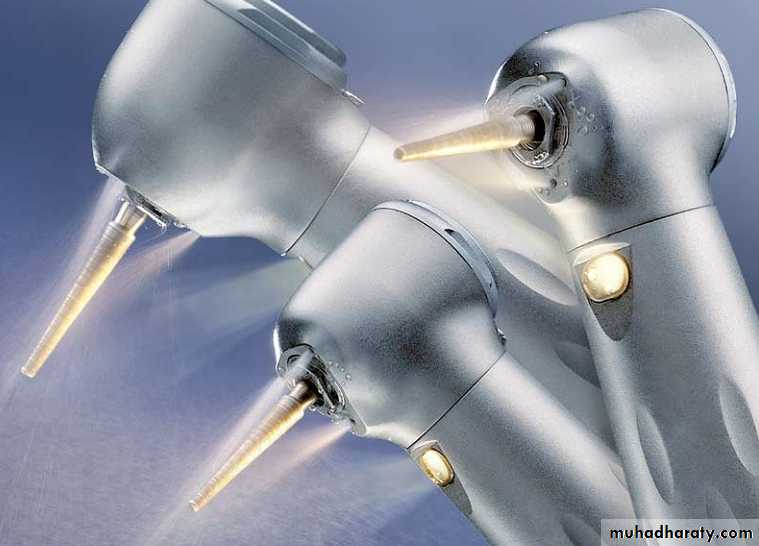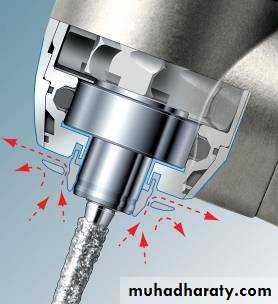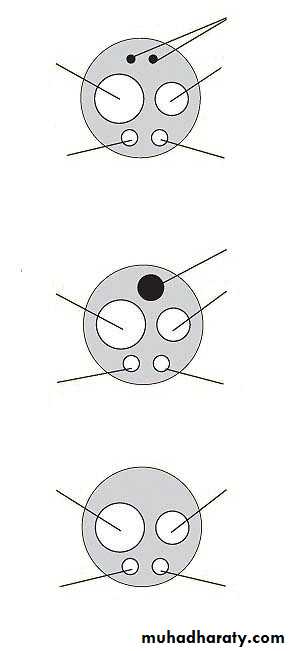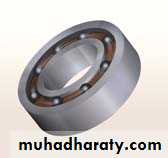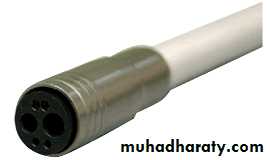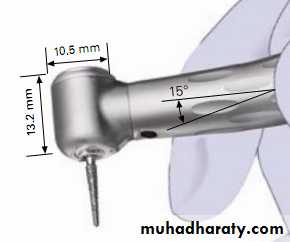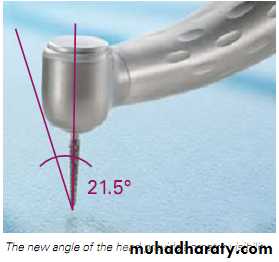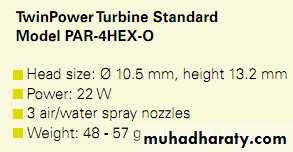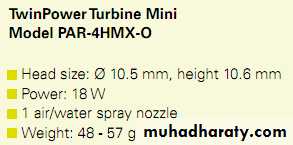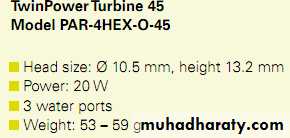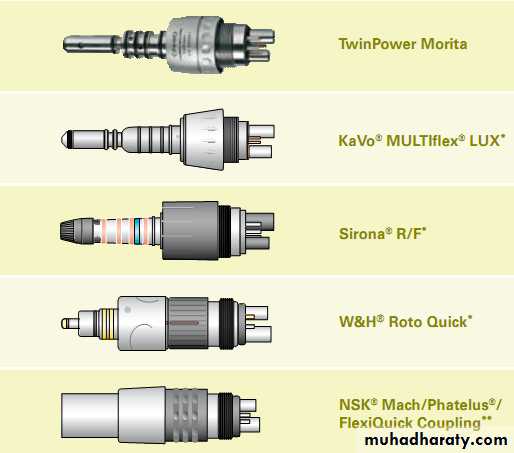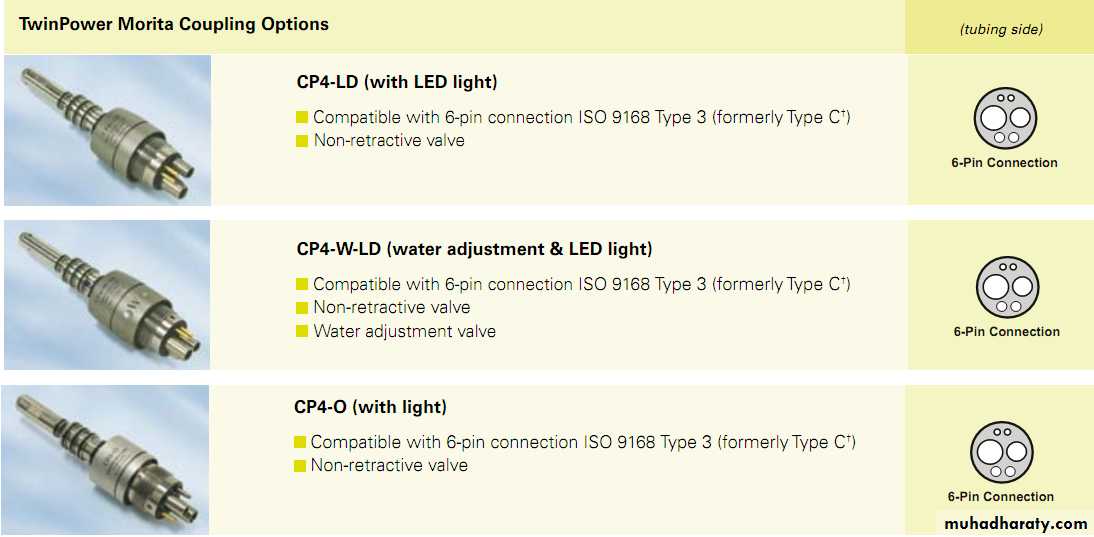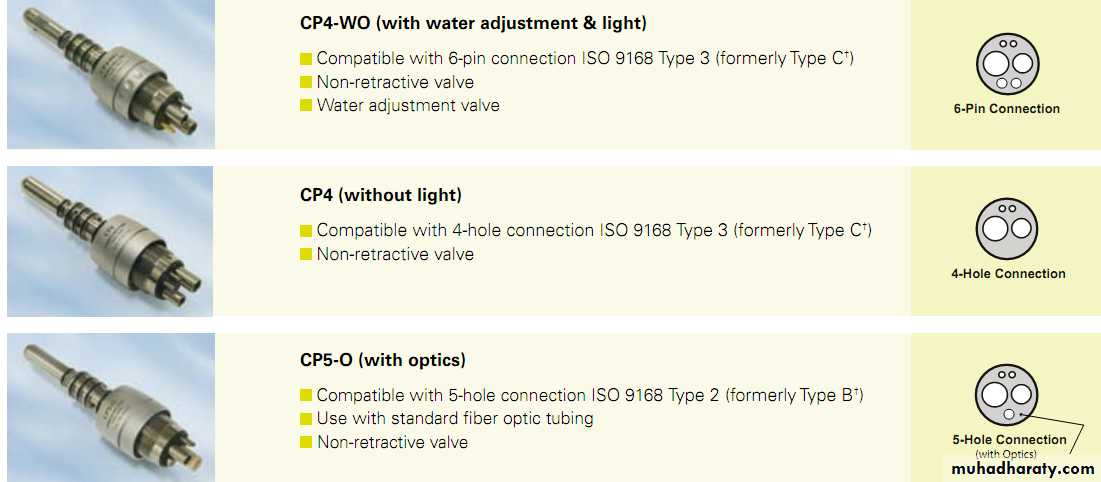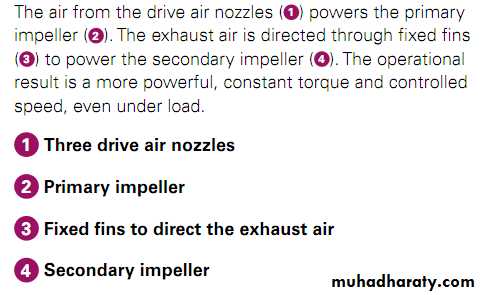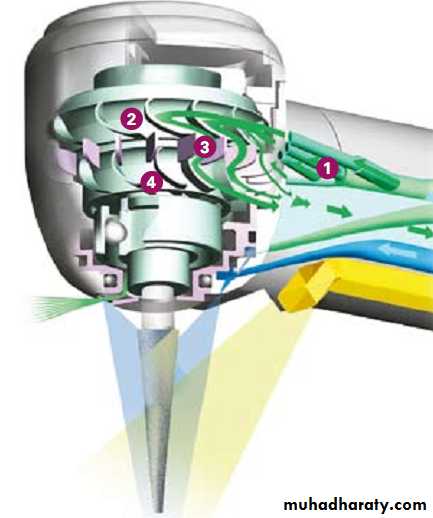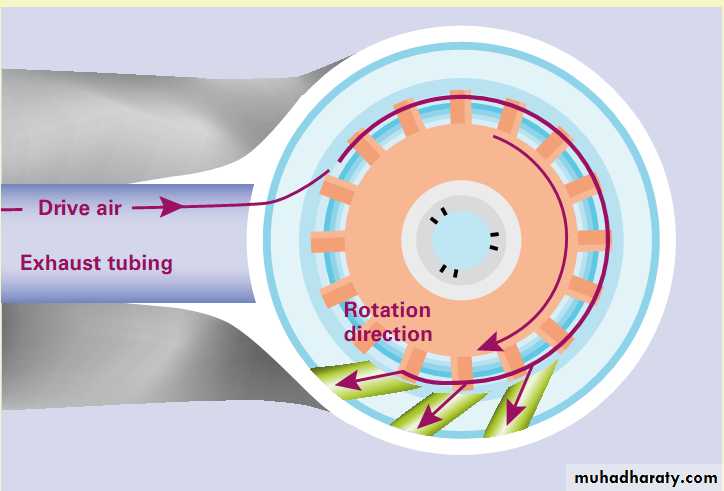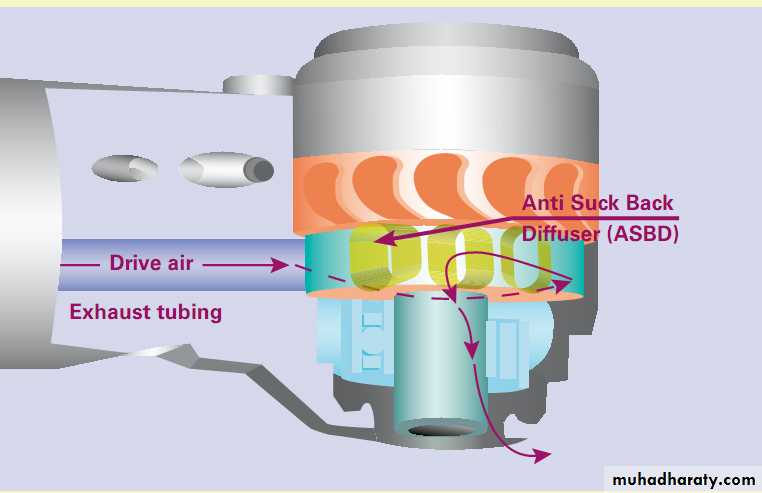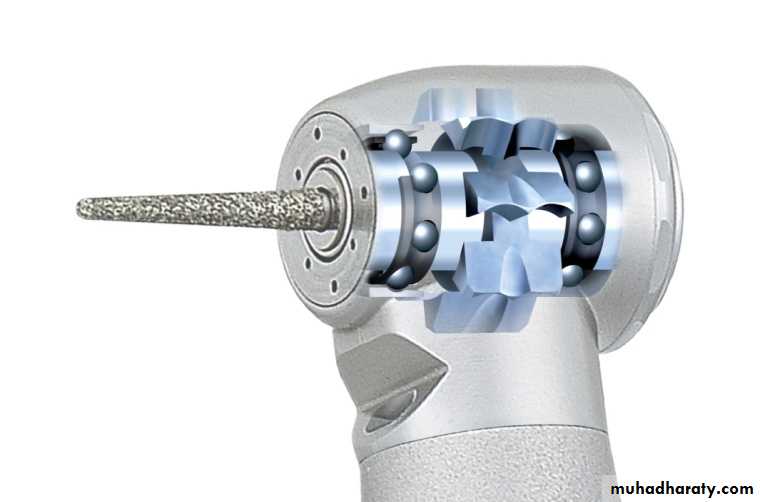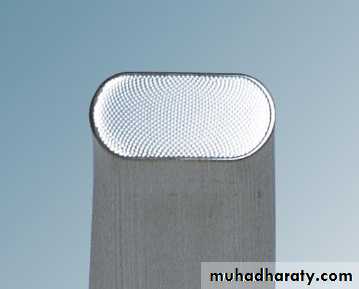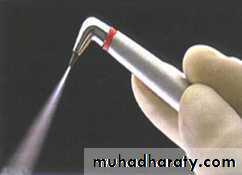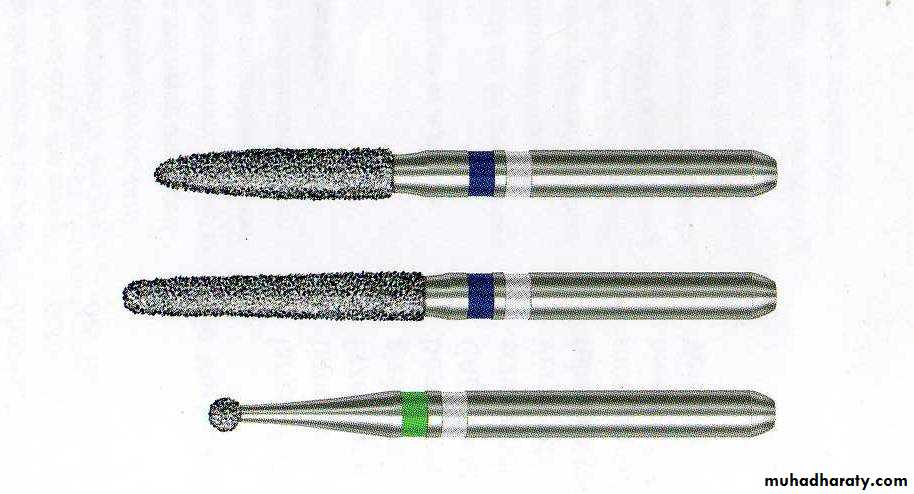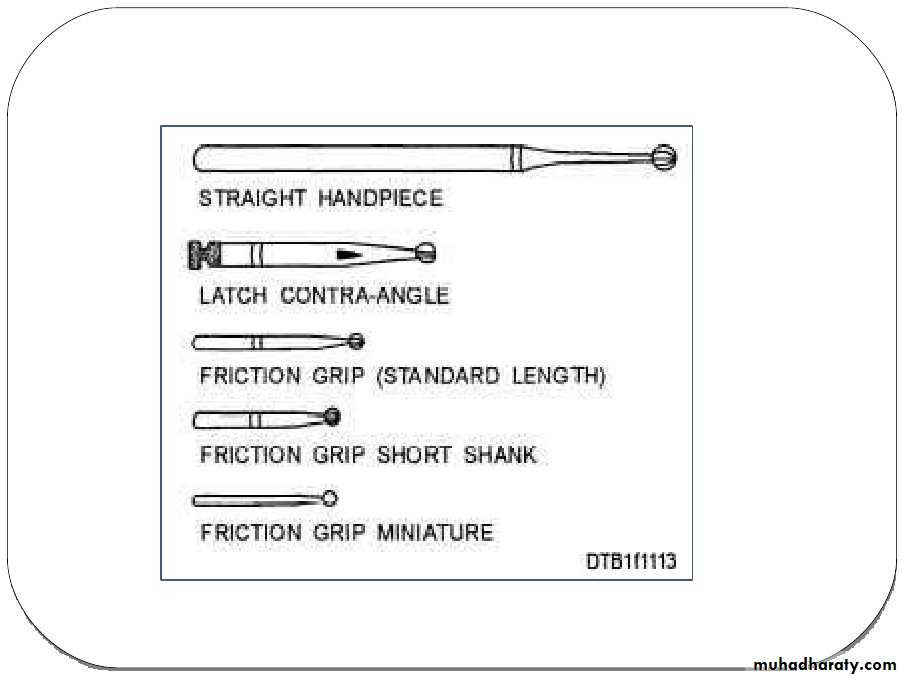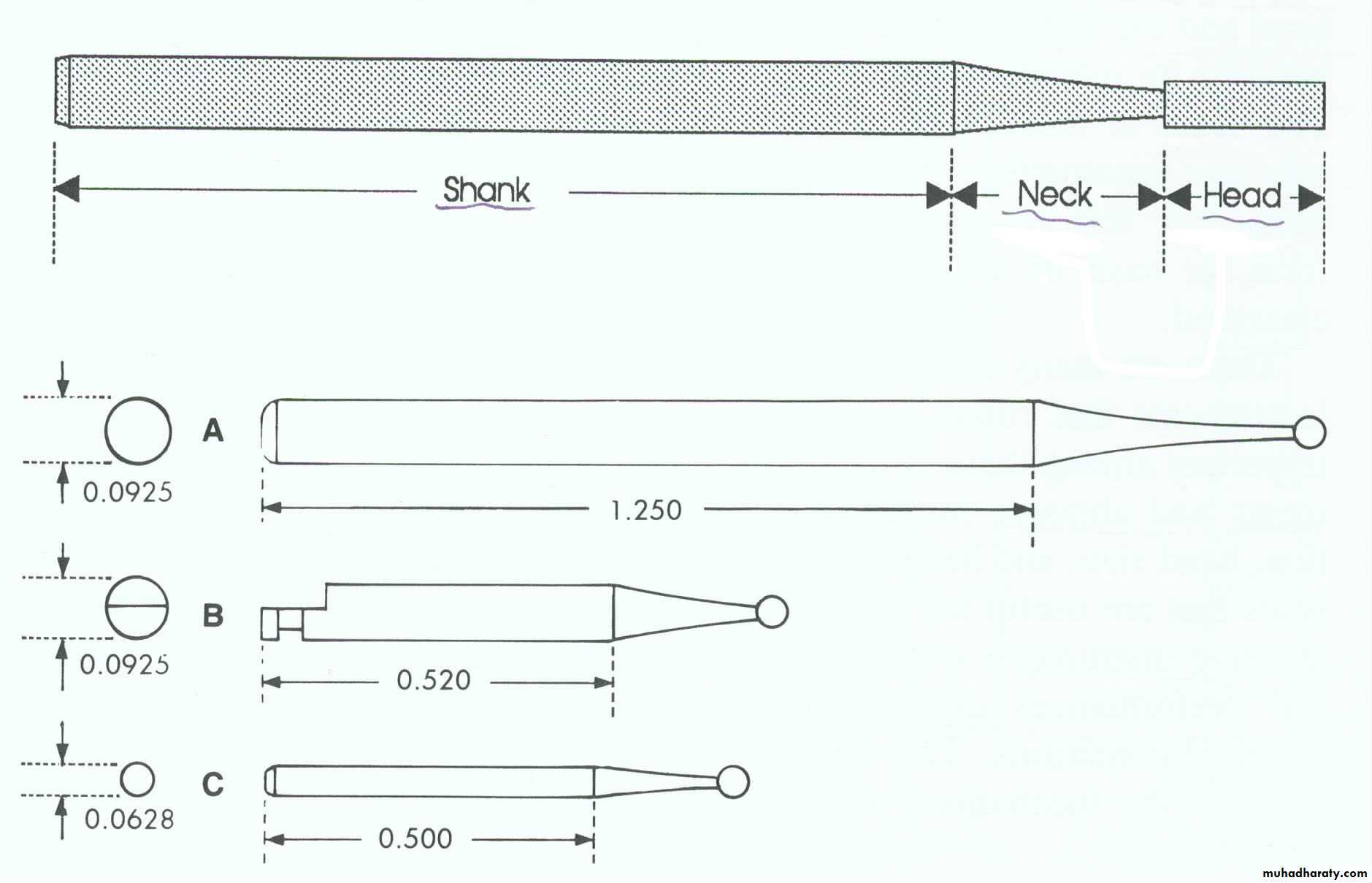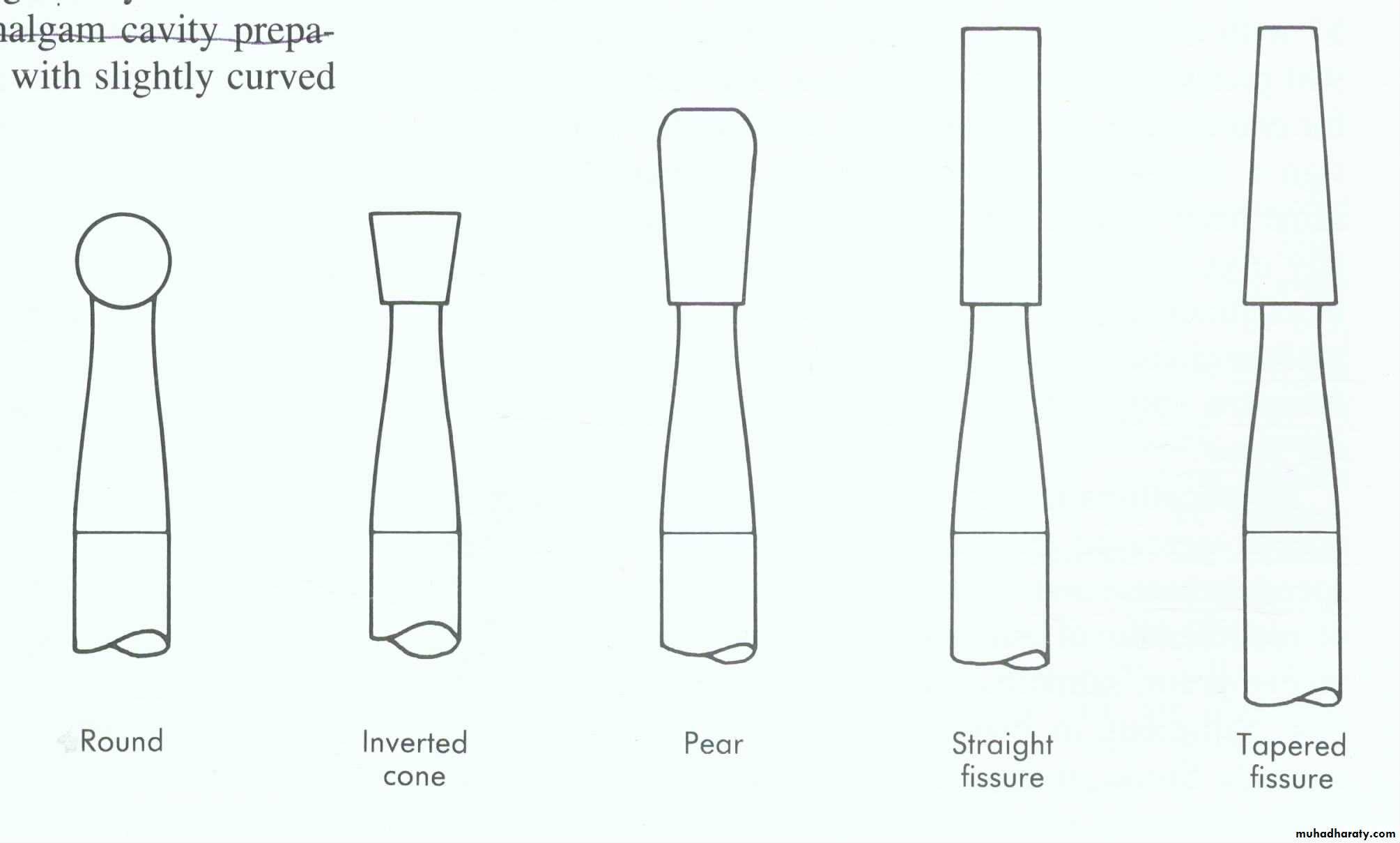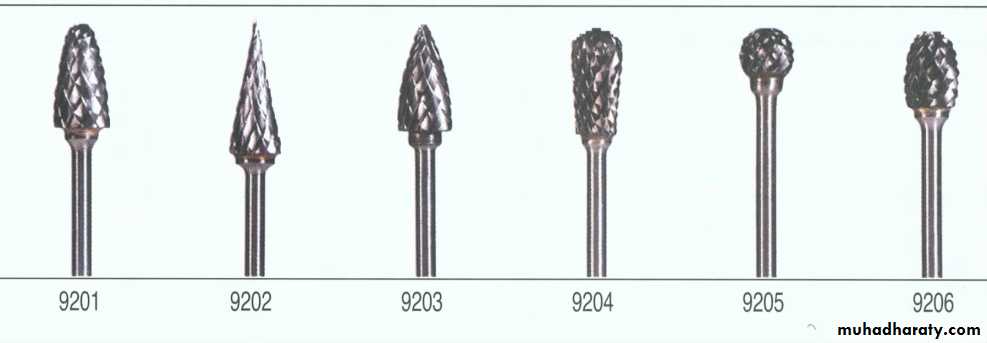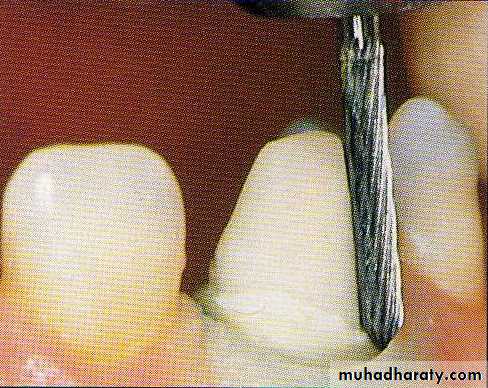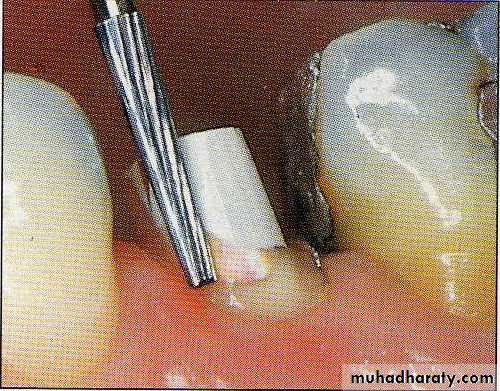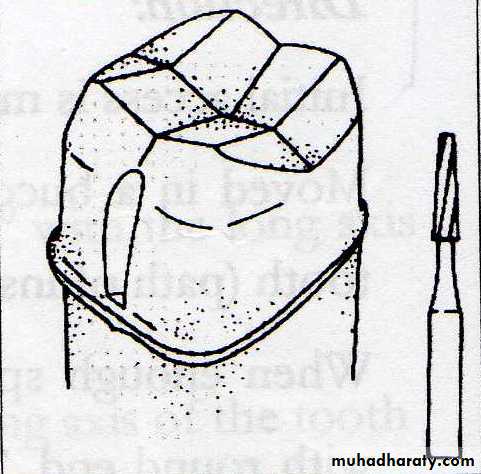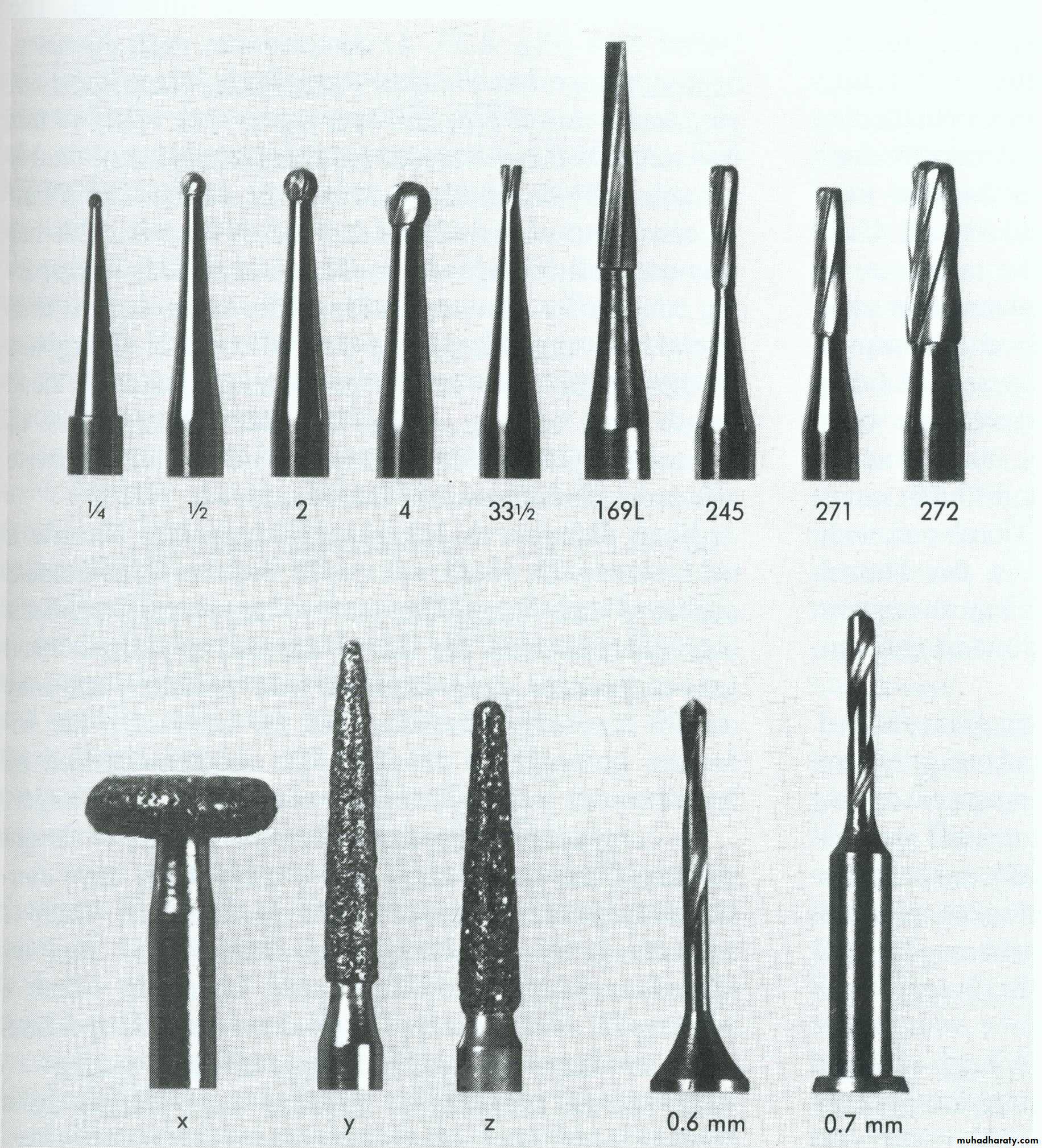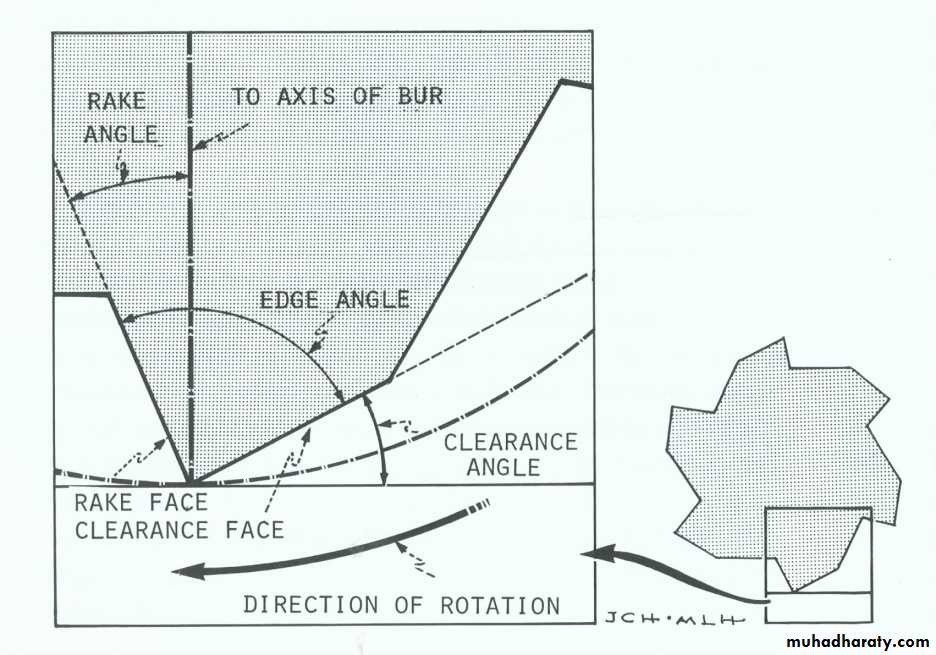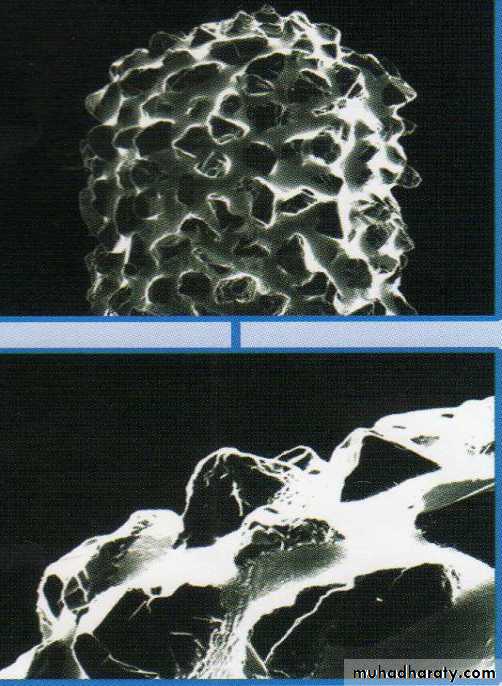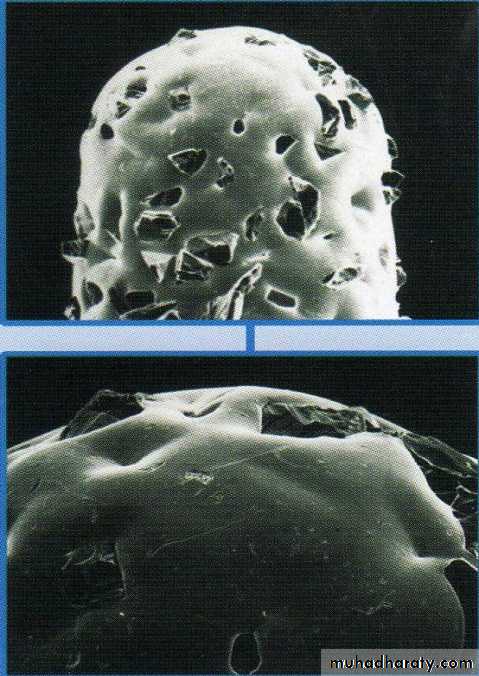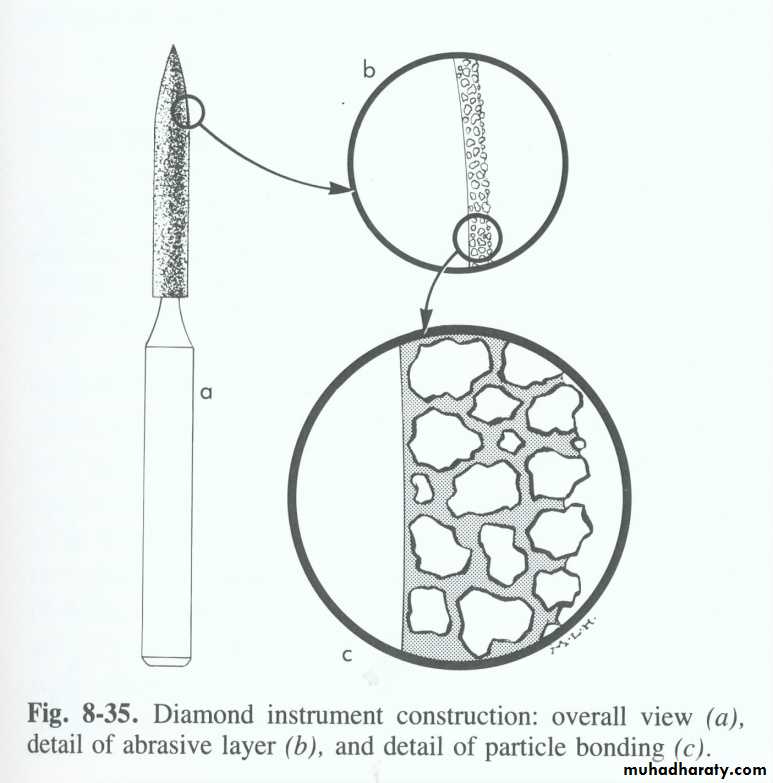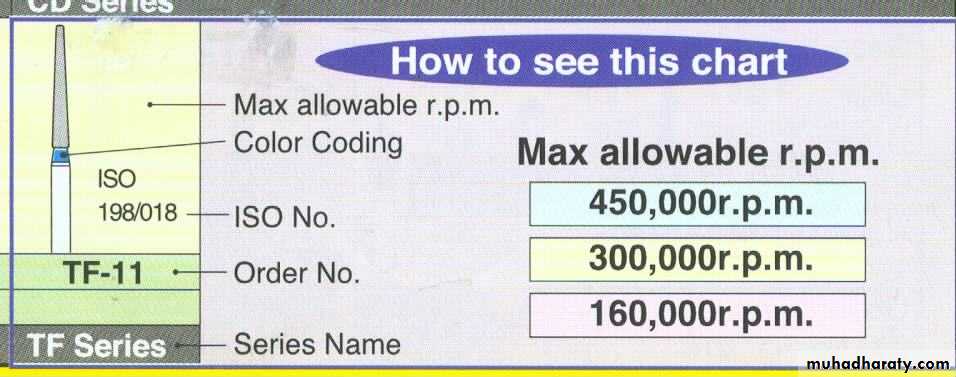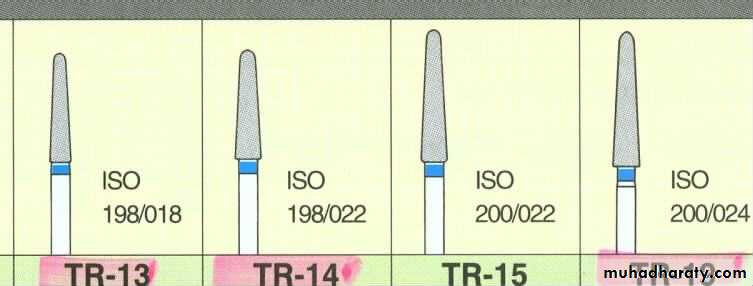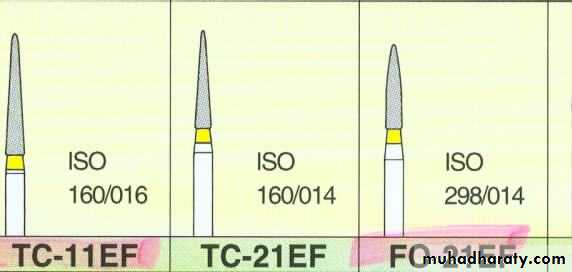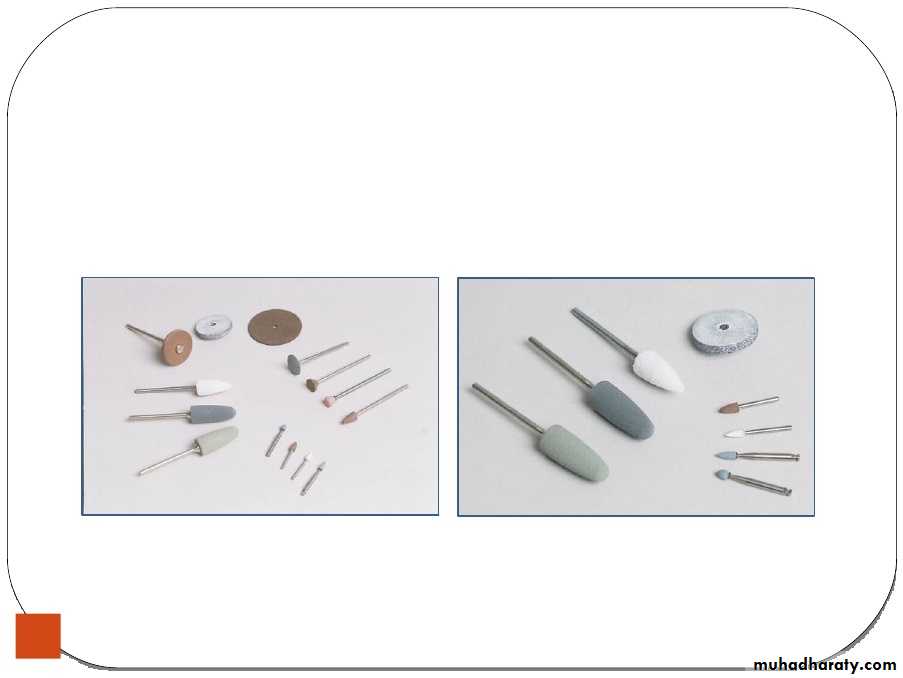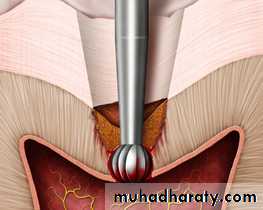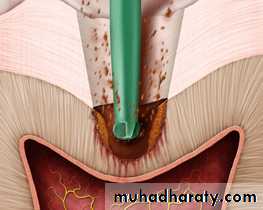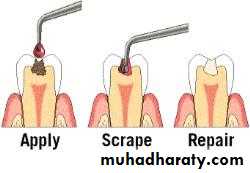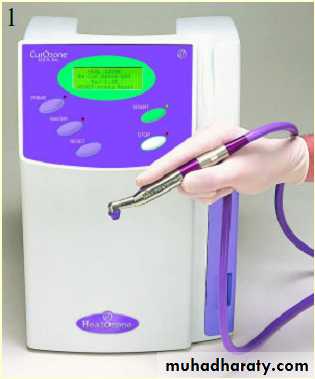Instruments in Operative Dentistry
1
معالجة نظري / ثالث اسنان كركوك
د.فاضل
2017/5/3
616
Outline:
Hand InstrumentsIntroduction
Classification
Materials
Application
Techniques
Sharpening
Powered cutting equipments
Rotary cutting instruments
Cutting Mechanism
Hazards
2
Introduction:
G.V. BlackNomenclature & numbering of hand instruments
• Cutting instruments/ excavators
• Noncutting
Designs of some early hand instruments
1728 – Pierre Fauchard invented the bow drill
1891 – Edward C Acheson –produced carborundum tools
1935 – W H Drendes - Diamond cutting instruments
3
Materials
Carbon Steel:Harder than stainless steel
Maintained better sharpness
Corrode in moist conditions
Carbon steel
4Stainless Steel
Preferred materialsRemains bright under most conditions
Loses keen edge during use much more quickly
Chromium: corrosion resistance
Carbon: hardness
Stainless Steel
5Tungsten carbide
Inserts or blades to provide more durable cutting edges (brittle).They may be soldered to steel handles
Some instruments are made with carbide to provide more durable cutting edges.6
Other alloys of nickel, cobalt, or chromium are used in the manufacture of hand instruments.
They are restricted to instruments other than those for cutting tooth structure
7Hardening and Tempering Heat Treatments
Heat treatment Furnace
The hardening heat treatment hardens the alloy, but it also makes it brittle, especially when the carbon content is high.Tempering heat treatment relieves strains and increases toughness.
8Classification of Instruments:- by Sturdevant
9Order
Purpose of the instrumentE.g. Excavator, scaler
Sub-order
Manner of use
E.g. Push, Pull
Class
Form of blade
E.g. Hatchet, Chisel
Angle
Number of angles in the shank: monoangle, biangle, triple-angle, quadrangle
E.g. Biangled hatchet excavator,
According to G. V. Black
10
Classification of Instruments:- by Charbeneau
Cutting instrumentsHand- hoes, chiesel etc
Rotary- burs, discs etc
Condensing instruments
Pluggers
Plastic instruments
Carvers, Burnishers
Finishing and polishing instruments
Discs, Strips
Isolation instruments
Cotton roll, Rubber dam
Miscellaneous-
Mirrors, Explorers
11
CLASSIFICATION BY MARZOUK
EXPLORING
INSTRUMENTS
REMOVAL OF
TOOTH STRUCTURE
RESTORATION
OF TEETH
To dry
To illuminate
Retraction
Probes
Separators
Mixing
Plastic
Condensing
Burnishing
Carvers
Files
Knives
Finishing
& polishing
Hand cutting
Rotary cutting
12
Design
13
Blade
Working part of the instrumentUsually in the form of a bevel (acute angle) that cuts into the tooth structure.
On non cutting instruments e.g. condensers the part corresponding to the blade is called the nib or face.
14
Shank
Connect the handle to the working end of the instrument.Normally smooth, round and tapered.
Mon-angle, bin-angle, triple angleBalance is accomplished by designing the angle of the shank so that the cutting edge of the blade must not be off axis by more than 1-2 mm (Sturdevant’s)/2-3 mm (Summitt)
15
Balance allows for the concentration of force onto the blade without causing rotation of the instrument.
Instruments with long blades may required two or three angles in the shank to bring the cutting edge near to the long axis of the handle
Such shanks are termed contra angled.
16
Handle/ Shaft
Serrated for better gripping and control of the instrument.• Standard Stainless steel handle: Diameter 6.4 mm approx.
• Padded handles: Diameter 8mm approx.• Larger diameter handles: 9.5 mm
17
Handles are in conjunction with the shank or it may be separable.
Separate type is known as cone-socket handle and allows for replacement of several working ends e.g. mirrors and condensers.18
cone-socket handle (mirror)
mirror19
Numeric formulas
Describing the dimensions and angle of the working end.Three number formula
Four number formula:Cutting edge is not perpendicular to the long axis of the blade.
Gingival marginal trimmer
Angle former
20
Instrument shank and
blade design85
21
Bevels
Most hand cutting instruments have on the end of the blade a single bevel that forms the primary cutting edge.Additional two secondary cutting edges that extend from the primary cutting edge for the length of the blade.
Allows cutting in 3 directions; facial and lingual walls of the proximal cavity
22
Bibeveled instrument have two bevels that form the cutting edge;
e.g. hatched excavator23
Single beveled instrument such as spoon excavator and gingival margin trimmer are used with lateral cutting movement.
24
Enamel hatchet also as a single beveled instrument used with direct cutting motion, a planning or lateral cutting designated for right (R) and left (L) to the instrument formula.
25
The cutting edge is perpendicular to the axis of the handle
e.g. binangle chisel.Instrument with slight blade curvature e.g.Wedelstaedt chisel.
26
Removal of caries and refinement of the internal parts of the preparation.
Used primarily for cutting enamel.Cutting instrument applications
27
Excavators
• Ordinary Hatchets• Hoes
• Angle formers
• Spoons
28
Ordinary Hatchets
It has the cutting edge of the blade directedIn the same plane as that of the long axis of the handle and
Is bibeveled.
29
Used primarily on anterior teeth for
Preparing retentive areas andSharpening internal line angles, particularly in preparations for direct gold restorations .
30
Hoe excavators
Primary cutting edge of the blade perpendicular to the axis of the handlePlaning tooth preparation walls and forming line angles.
It is commonly used in Classes III and V preparations for direct gold restorations.
31
Hoes with longer and heavier blades, with the shanks contra-angled.
For use on enamel or posterior teeth.32
The blade angle of the hoe: > 12.5 centigrades
The blade angle of chisel: ≤ 12.5 centigrades33
Angle former
It is mon-angled and has the primary cutting edge at an angle (other than 90 degrees) to the blade.It is available in pairs (right and left )
34
Used primarily for sharpening line and point angles and creating retentive features in dentin in preparation for gold restorations
Also may be used in placing a bevel on enamel margins
35Spoon excavators
Its blades are slightly curved, the shanks may be bin-angled or triple-angled to facilitate accessibility.
The cutting edges are circular
The cutting edges are claw like.36
Left cutting and right cutting
Used mainly for removal of caries and refinement of internal opening in a cavity preparation37
bin-angled spoon
triple-angled spoon38
Cleoid spoon
39Discoid spoon
Discoid is disc shaped, with cutting edge around the blade40
Chisels:
Straight, Monoangle, Biangle, Wedelstaedt chiselsEnamel Hatchets
Gingival Marginal Trimmers41
Straight Chisel
The straight chisel has a straight shank and blade, with the bevel on only one side.
Its primary edge is perpendicular to the axis of the handle.
(12-7-0)
42The shank and blade of the chisel also may be slightly curved (Wedelstaedt design)
11½-15-3
Biangled chisel
43Force used with chisels : straight thrust
The bin-angle and Wedelstaedt chisels:
Primary cutting edges in a plane perpendicular to the axis of the handle.
Distal bevel or a mesial (reverse) bevel.Used for cleaving undermined enamel and for shaping walls.
Instrument with three cutting motion: vertical, right and left.44
The blade with a distal bevel is designed to plane a wall that faces the blade's inside surface
The blade with a mesial bevel is designed to plane a wall that faces the blade's outside surface
45
Enamel Hatchet
It is a chisel similar in design to the ordinary hatchet excavator except that the blade is larger, heavier, and is beveled on only one sideCutting enamel
Right or Left cutting ends of the double- ended hatchet.
10-7-14
46Gingival margin trimmer
Blade is curvedBevel for cutting edge: outside of the curve
Face of instrument: inside of the curve
47
12½-100-7-14
12½-75-7-14Mesial
Distal
48
Cutting edge angle: 100 and 75 :
Inlay & Onlay preparations.
Cutting edge angle: 90 and 85 :
Amalgam preparations.49
Uses:
Beveling of the gingival margins of proximo-occlusal preparations.Beveling of the axio-pulpal line angle
Performing a gingival lock (reverse bevel), placed on the gingival seat
50
Usage of hand cutting instruments
Horizontal strokes:Long axis of blade directed between 45 & 90 degree to the surface being planed or scraped
Vertical or chopping strokes:
Pulling stroke
Hoe: beveled end or distal bevel
Pushing stroke
Hoe: contrabeveled end or mesial bevel.
51
The cutting edge of the hand instrument should always be kept sharp as
Dull instruments may cause:
1. Loss of control.2. More pain.
3. Prolonged time for the operative procedure.
4. Reduce the quality and precision of tooth
preparation.
Sharpening
52
sharpening equipment
Stationary sharpening stone e.g. Arkansas stone, silicon carbide.53
Mechanical sharpener; moves at low speed while the instrument is held at the opposite angle and supported by a rest i.e. easier and less time consuming.
E.g. Rx Honing Machine
Mechanical sharpener
54
Principles of Sharpening
Sharpen instruments only after they have been cleaned & sterilizedEstablish the proper bevel angle (usually 45 degree) and the desired angle of the cutting edge to the blade.
Use light stroke pressure
Use a rest or guide whenever possible.
Remove as little metal as possible
55
Non cutting Instruments
Diagnostic instrumentsMirror
Probe or explorer
Twizzer
Plastic instruments
Amalgam instruments
Condensers
Burnisher
Carver
Amalgam carrier
56
Mouth Mirror
Most common sizes used are the No. 4 (⅞ inch diameter) and No. 5. (15/16 inch diameter)
No. 2 (5/8 inch diameter): when working on posterior teeth with a rubber dam.
For clarity, reflective surface on the external surface of the glass: Front surface mirror.
57
Uses for the mouth mirror. A, Indirect vision. B, Light reflection. C, Retraction. D, Tissue protection.
A
D
C
B
58
Explorers
To feel tooth surface for irregularities
To determine the hardness of exposed dentin
• Shepherd’s hook: No. 23
• Cowhorn explorer: No. 2
• No. 17: back action
59
Tweezer/ cotton forceps:
Cotton forceps are used for picking up small items, cotton pellets60
61
Plastic filling Instruments
To carry and shape tooth colored restorative material: Composite resin and glass ionomerFor placing of base and lining material
Hard plastic or metal.
Composite placement instrument
Designed specifically for the placement of composite restorative materials.Anodized aluminum
Teflon
Titanium nitride layer on instruments
62
A: ash49 B:ash6 C:dycal applicator D:cement spatula.
63Amalgam Carriers
An instrument with a hollow cylinder that is filled with amalgam.
Sizes:
Mini: 1.5 mm diameter
Regular: 2.0 mm
Large: 2.5 mm
Jumbo: 3.0-3.5 mm
64
Amalgam Condensers
Various Amalgam condensers
65Carvers
Hand instruments with a blade or nib used to contour the surface of filling material in their plastic state, waxes, models and patterns.Hollenback carver (knifed edged- elongated- bibevelled)
Diamond (Frahm’s) carver : Bibevelled cutedge.
Ward’s ‘C’ carver
Discoid Cleoid
Interproximal carver
66
67
Burnishers
Burnishing of the amalgam on the margins of the cavity,Shaping metal matrix band to have more desirable contours for restoration.
To bend cast gold restoration (inlay or onlay) near the margin of the prepared cavity to narrow the gap between gold and the tooth.
68
Burnishers
69Disposable brush
Used with etching and bonding procedures associated with composite resins.
70
Accessory Instruments
ScissorsUsed for cutting dental dam material, retraction cord, and stainless steel crowns.
Crown and bridge scissors
Dappen Dish
Hold certain liquid dental materials during a procedure.71
Howe Pliers
Also referred to as 110 pliers. Useful for holding items, for carrying cotton products to and from the oral cavity, removing the matrix band, and placing and removing the wedge.Guards
Interproximal wedges to protect soft tissues from contact with sharp rotary cutting instruments.72
Preset restorative tray
73There are four grasps used with the hand
instruments:Modified pen.
Inverted pen.Palm and thumb.
Modified palm and thumb.Instrument grasp
74Modified pen grasp
pen grasp
Modified pen grasp75
Inverted pen grasp
If the hand is rotated so that the palm faces more toward the operator.Used in the lingual and labial surfaces of anterior teeth.
inverted pen grasp
76Palm and thumb grasp
The handle of the instrument is placed on the palm of the hand and grasped by all the fingers while the thumb is free of the instrument and rest on the nearby tooth of the same arch.Preparing incisal retention in a class III preparation on a maxillary incisor.
77
Palm and thumb grasp
The same as in palm and thumb grasp but the thumb is rested on the tooth being prepared.Used in the upper arch.
78
Powered cutting equipments
79
Characteristics:
• Speed• Surface feet per unit time of contact that the tool has with the work to be cut or revolutions per minute
• According to Marzouk:
• Ultra low speed: 300-3000 RPM
• Low speed: 3000-6000 RPM
• Medium High Speed 20,000-45,000 RPM
• High Speed 45,000-1,00,000 RPM
• Ultra High Speed > 1,00,000 RPM
80
According to Charbenau:
• Conventional or low speed: below 10,000 RPM
• Increased or high speed: 10,000-1,50,000 RPM
• Ultraspeed: above 1,50,000 RPM
• According to Sturdevant:
• Low or slow speeds: below 12,000 RPM
• Medium/Intermediate speeds: 12,000 to 2,00,000 RPM
• High/ Ultrahigh speeds: above 2,00,000 RPM
81
Pressure:
P=F/ALow speed: 2-5 pounds of force
High speed: 1 pound of force
Ultra high speed: 1-4 ounces of force
Heat Production
Directly proportional to the Pressure, RPM, and area of tooth in contact113˚ F : Pulpitis & pulp necrosis.
130˚ F : Permanent damage of pulps.
82
Brown et al: Temperature of dentin at a distance of 0.5 mm from a high speed bur cutting dry to be 245˚F (118˚C).
Even in non vital teeth, dry cutting at high speed should be avoided, since the thermal stresses will cause microfractures in the enamel. This could contribute to marginal failure of the restoration.
Higher water velocity.
Clean head system
83Greater flow of water coolant is required to prevent clogging when diamonds are used under increased pressure.
42 psi is the optimal air pressure to achieve peak performance
Optic
Drive airSpray water
Exhaust air
Spray air
Optic
Drive air
Spray water
Exhaust air
Spray air
6-pin
5-hole
84
Vibration:
Equipment used & the speed of rotation
Excessive vibration: annoyance to the patient, operator fatigue and rapid wear of instruments.Torque:
Ability of the hand piece to withstand lateral pressure on the revolving tool without decreasing its speed or reducing its cutting efficiency.85
Friction:
Occurs in the moving parts of the hand piece especially the turbine.Friction is reduced by equipping the hand piece with ball bearings, needle bearings, glass and resin bearings.
Ceramic Ball Bearings:
40% lighter and 3 times harder than conventional bearings, they offer an extended turbine life, reduced operation noise, and less vibration.86
Handpieces:
Two basic types of handpieces, the straight handpiece and contra angle handpiece.The straight is used more frequently for laboratory work, while contra angle used in the oral cavity.
High speed techniques are generally preferred for cutting enamel and dentin.
87
Penetration through enamel and extension of the cavities outline are more efficient at high speed.
Small diameter burs should be used in the high speed handpiece.
High speed generates considerable heat during cutting, even with small diameter burs and should be used with water coolant and high efficiency evacuation
88
Design:
This model is the choice for limited access or when treating children.
Rear-facing exhaust vents direct air flow away from the surgical site for patient protection
89
Commonly used couplings
90
91
92
Zero Suck Back Technology
Prevents the intake of aerosol and other particles when it is stopped.Drive air flows into an Anti Suck Back Diffuser (ASBD) within the capsule.
Air in the ASBD is pressurized through centrifugal force created by the impeller rotation.Through the centrifugal force and rotation of the impeller, air continues to flow into the ASBD and remains pressurized even after drive air is stopped.
The pressurized air in the ASBD is released to the outside at the bottom of the head
93
Low-Speed Handpiece
DesignStraight in appearance.
Standard length and “short.”
Speed ranges from 10,000 to 30,000 rotations per minute (rpm).
Operates the rotary instrument in either a forward or backward movement.
94
Uses of the low-speed handpiece
IntraoralRemoval of soft decay and fine finishing of a cavity preparation.
Finishing and polishing of restorations.
Coronal polishing and removal of stains.
Extraoral
Trimming and contouring temporary crowns.
Trimming and relining of removable partials and dentures.
Trimming and contouring of orthodontic appliances.
95
Low-Speed Attachments
Straight attachment receives a long‑shank laboratory bur, the contra-angle attachment, and the prophy angle attachment.Contra-angle attachment receives latch type rotary instruments and mandrel.
96Prophylaxis Angle
Used during polishing procedures to hold the prophy cup and bristle brush.Two types
Plastic disposable “prophy” angle
Metal “prophy” angle
97
High-Speed Handpiece
DesignOne-piece unit with a slight curve in appearance.
Operates from air pressure.
Operates at speeds up to 450,000 rpm.
Maintains a water-coolant system.
Friction-grip locking system for rotary instruments.
Fiber-optic lighting.
Cellular Glass Optics
98Uses of the high-speed handpiece
Removes decay.Removes an old or faulty restoration.
Reduces the crown portion of the tooth for the preparation of a crown or bridge.
Prepares the outline and retention grooves for a new restoration.
Finishes or polishes a restoration.
Sections a tooth during a surgery.
99
Ultrasonic Handpiece
DesignAttached to the dental unit.
Powered by electricity.
Attachments are similar in appearance to scaling instruments.
Delivers a pulsating spray of water.
100
Uses of the ultrasonic handpiece
Removes calculus.Removes stain.
Removes bonding materials from a tooth surface after orthodontic appliances are removed.
Removes cement after orthodontic bands are removed.
101
Laser Handpiece
Design
Uses a laser light beam instead of rotary instruments.
The laser is conducted through a fiber‑optic cable.Resembles a standard handpiece.
Maintains a water-coolant system.
Maintains an air-coolant system
102
Uses:
Cauterizes soft tissue.Vaporizes decayed tooth structure.
Advantages:
Usually painless.Patient usually does not require anesthesia.
Proceed with procedure faster.
Disadvantage:
Cannot be used on teeth with existing restorations.103
Air-Abrasion Handpiece
DesignSmall version of a sandblaster.
Compressed air at pressure of 7 to 11 atm (40 to 140 psi)Produces a high‑pressure delivery of aluminum oxide particles (of 20 to 50 pm) through a small probe.
104
Uses:
Prepares teeth for sealants.Removes external stains.
Class I through class VI preparations.Endodontic access.
Crown margins.
Prepares a tooth surface for the cementation of a cast restoration, such as a crown or veneer.105
Disadvantages:
More effective on hard normal dentine than soft dentine affected dentineWhen using composite, the air abrasion doesn’t provide the micromechanical roughness needs for retention thus needs acid-etchant.
Loss of tactile sensation.
106Possible iatrogenic damage especially on the cementum and root dentine.
Can induce asthma –> thus needs high volume suctionCan’t remove amalgam restoration.
Can’t perform massive reduction for crown.
107Laboratory Handpiece
DesignOperates at speeds up to 20,000 rpm.
Uses laboratory burs.Provides greater torque than handpieces used intraorally.
108Rotary instruments
CuttingAbrasive
Carbide burs
Made from1- tungsten carbide
2- steel carbide
1- Diamond burs
2- Discs3- Stones
4- Rubber wheels
109
According to composition:
• Steel burs• Tungsten Carbide burs
• According to mode of attachment to handpiece
• Latch type
• Friction grip type
• According to handpiece they are designed for;
• Clockwise
• Anticlockwise
110
Rotary instruments consist of three parts :
1- shank
2- neck (shaft)
3- head
head
shaftShank
111
Shank design
Long shank – used for straight hand piece (low speed)Short latch shank – used for contra-angle (low speed)
Friction grip shank - used for high speed hand piece112
113
114
Dental Burs
A group of instruments that can turn on an axis with different speed of rotation to perform different types of work.The characteristics of this work are either cutting , abrasive, finishing or polishing.
Steel burs cut human dentin at low speeds, but dulls rapidly at higher speeds or when cutting enamelSteel necks bends easily causing vibration
115Carbide burs
Burs possess blades that shear (cut) tooth structure.
They are used for making precise intracoronal preparation features such as placing groove, and boxes.
Used for smoothing surface in enamel and dentin
They are not used for bulk reduction because to producing undulations on the tooth surface
116
Shapes:
Round Bur:Initial entry into the tooth
Extension of the preparation
Retentive features and caries removal
Inverted cone bur
Undercuts in the tooth preparation
Pear shaped bur
Tooth preparation for amalgam, gold foil.
Straight fissure bur
Tooth preparation for amalgam
Tapered fissure bur
Tooth preparation for indirect restorations.
117
Basic bur head shapes
118Coarse-cut
Regular –cut
Fine Cut
119
Twelve-fluted carbide bur
Its used for highly smoothing of prepared surfaces of toothBecause of its blades in a diagonal to the instrument shaft
Its have a torpedo shape
120
Plain fissure bur
Its tapered and cylinder shape its used for placing groove and boxes and they also used for finishing of preparation.Groove seating
121Bur numbering systems
In the united states the burs have been traditionally described in term of arbitrary i.e. numerical code
eg, 2 =1 mm diameter round bur,
34 = 0.8mm inverted,
57 = 1mm diameter straight fissure
Number 500 is added to indicate cross cutting
Number 900 is added to indicate end-cutting onlySo no. 57 ,557 and 957 are all had the same head size
122Iso system(international standard organization)
FDI (Federation dentaire internationale)Usually tend to use head shape name and size
(in tenth of a millimeter)Eg. Round 010 = 1mm diameter
Straight fissure plain 010 = 1mm diameter
Inverted cone 008=0.8mm diameter
123124
Shapes & diameters of regular carbide burs used for tooth preparation
RoundBur size: 1/16 1/8 ¼ ½ 1 2 3 4 5 6 7 8 9 11
Diameter: 0.30 0.40 .50 .60 .80 1.0 1.2 1.4 1.6 1.8 2.1 2.3 2.5 3.1
Inverted cone
Bur size: 33½ 34 35 36 37 39 40
Diameter (mm): .6 .8 1.0 1.2 1.4 1.8 2.1
Straight Fissure:
Bur size: 55½ 56 57 58 59 60
Diameter (mm): .60 .80 1.0 1.2 1.4 1.6
Straight fissure, round end:
Bur size: 1156 1157 1158
Diameter (mm): .80 1.0 1.2
Tapered fissure:
Bur size: 168 169 170 171
Diameter (mm): .80 .90 1.0 1.2
125
Tapered fissure, rounded end
Bur size: 1169 1170 1171
Diameter (mm): .90 1.0 1.2
Pear:
Bur size: 329 330 331 332
Diameter (mm): .60 .80 1.0 1.2
Long inverted cone, rounded corners (amalgam preparation)
Bur size: 245 246
Diameter (mm): .80 1.2
End-cutting:
Bur size: 956 957
Diameter (mm): .80 1.0
126
Bur head design:
The number of blades on a bur is always evenNumber of blades on an excavating bur may vary from 6 to 8 t0 10.
Finishing bur: 12 to 40 blades127
Concentricity:
Measurement of the symmetry of the bur head.Runout:
Test measuring the accuracy with which all blade tips pass through a single point when the instrument is rotated.Average value of clinically acceptable run-out is about 0.023 mm
Is the primary cause of vibration128
Bur blade design
129
Rake angle:
Angle that the face of the bur tooth makes with the radial line.Radial rake angle: radial line & the tooth face coincide.
Negative rake angle: blade face is leading the radial line
• Increases the life expectancy of the bur & provides for the most effective performance in low and high speed ranges.Positive rake angle:
Produce acute edge angle130
Edge angle:
In the range of 90˚ to provide strength to the blade & longevity of cutting efficiency of the bur.Land: plane surface immediately following the cutting edge.
Flute/ Chip space:Space between successive bur teeth or the blades of the bur.
Provides an exit for removal of the fractured matter and creates a clearance angle.
131
Clearance angle:
Angle between the back of the blade and the tooth surface.
If a land is present on the bur:• Primary clearance angle: the angle the land will make with work.
• Secondary clearance angle: the angle between the back of the bur tooth and work.
• Radial clearance angle: is formed when the back surface of the bur tooth is curved.
Provides clearance between the work & the cutting edge to prevent the tooth back from rubbing on the work.
132
Abrasive instruments
Head consists of small angular particles of hard substance embedded in a soft binder (ceramic, metal, shellac, rubber).Diamond abrasives
Other abrasives –Silicon carbide (carborundum), aluminium oxide, garnet, quartz, pumice, cuttlebone.
Deposited by Electroplating, sintering or microbrazing.
133Diamond stones
These are made from diamond chips bonded to blanks (heads). Diamonds used for grinding enamel and dentin surfacesDiamond burs may divided according to :
1- coarseness ( medium grit - fine grit )
2- shape
Medium grit
Fine grit
134Diamond particle size:
1) Coarse: 125~150 um2) Medium: 88~125 um
3) Fine: 60~74 um
4) Very fine: 38~44 um
Diamond instruments consists of three parts:
A metal blank,
The powdered diamond abrasive
A metallic bonding material that holds the diamond powder onto the blank
135
Color coding:
Coarse: 120-150µ
Standard: 106-125µ
Fine: 53-63µExtra- fine: 20-30µ
TF: Taper flat end; TR: Taper round end; TC: Taper conical end; FO: Flame Ogival end; SF: Straight flat end; SO: Straight Ogival end; BR: Ball round; WR: wheel round edge;Green
Blue
Red
Yellow
136
137
Discs, Mandrel, Stones, and Wheels
138
Moulded abrasive instrument –
Manufactured by pressing a uniform mixture of abrasive and matrix around roughened end of shank,Points and stones; finishing & polishing
Coated abrasive instrument –
Disks that have a thin layer of abrasive cemented to a flexible backing.surface contouring, finishing
139
SmartPrep Instruments
• SmartPrep Instruments (Smart Bur, Polymer Bur)
• Medical polymer that has the ability to remove decayed dentine while keeping the healthy dentin.• Its hardness is less than healthy dentine while harder than the carious dentin.
• Ability to self-limit(selectively)
It will only cut what is carious and if it’s in contact with healthy dentin the bur will only wear away (when extensive force isn’t used).
140
Advantages:
ConservativeMinimal to none disease transfer (because its single use only).
No need for Local Anesthesia.
For Students to start with first clinical cases.
141
Disadvantages:
Single-patient-use = Expensive.
Technique sensitive ( too much pressure and you will cut the healthy dentine)The bur breaks down when it touches enamel.
It can sometimes leave large amounts of decayed tissue (use caries dye to locate the left amount.Access should be done by a different type of bur that can penetrate the enamel.
142Cutting Mechanisms
Bladed Cutting:Brittle fracture: crack production, by tensile loading.
High speed cutting, especially of enamel
Ductile fracture: plastic deformation, by shear.
Low speed cutting.
Abrasive Cutting:
Diamonds are most efficient when used to cut brittle materials, are superior to burs for removal of the dental enamel.
Burs are generally preferred for cutting ductile materials such as dentin.
143
Cutting Recommendations
Use of contra-angled handpiece, air-water spray for cooling, high operating speed (above 200,000 rpm), light pressure.Carbide burs are better for end- cutting, produce lower heat, and have more blade edges per diameter for cutting.
Diamonds are more effective than burs for both intracoronal & extracoronal tooth preparations, beveling enamel margins on tooth preparation, & enameloplasty.
144
Chemo-Mechanical Caries Removal
Carisolv (Chemo‐mechanical caries removal )Composition:
0.5% sodium hypochlorite and 0.1 M amino acids “Glutamine, leucine and lycine”
This is a technique used to remove caries and decay with minimal invasive techniques.
Hypochlorite: dissolves the decayed dentine
Amino acid: buffering solution to prevent damage to the healthy tissue.
[The amino acid and hypochlorite will react with the denatured Collagen Tissue of dentine (Infected dentine) making soft and easily removed with hand instruments.]
145
Advantages:
Less anesthesia is used
Useful for children, dental‐phobic patients.Useful for removing root or coronal caries in easily accessible areas.
Removes the smear layer and doesn’t affect the bond strength of the adhesive materials.
No histological effect on the pulp even with direct contact.
146
Ozone treatment
Ozone gas has a high oxidation potential and is effective against bacteria, viruses, fungi, and protozoa.Capacity to stimulate blood circulation, platelets, and immune response.
Ozone is used in dentistry in gaseous, ozonated water and as ozonated oilsOzone has been proven to halt root caries and also reverse lesions (pit and fissure carious lesions) by allowing the natural remineralisation process to proceed.
Remineralised lesions are known to be more resistant to further dissolution than sound tooth surfaces.
147
Disruption of the protected ecological niche of the micro-flora allows remineralisation from the saliva.
Intracanal irrigants in endodontic treatment.
Treatment of alveolitis, avascular osteonecrosis of the jaw, and herpes virus infection.Inhibits plaque formation: periodontal surgical and maintenance phase.
Used in dental unit water line to disinfect water.Advantage of ozone therapy is it is an atraumatic, biologically based treatment.
148O3 delivered from the HealOzone unit: (2100 ppm O3, 615 ml/min) through a hand piece with a silicone cup that sealed the tooth.
Once sealed, the device automatically delivered the O3 for the treatment group for 10 seconds followed by 10 seconds vacuum.
Recall:
After one and three months.
Prophylaxis of teethRe-examination using the DIAGNOdent® and ECM readings.
Ozone treatment repeat on each of these two recall visits.
149
Hazards with cutting Instruments
Pulpal Precautions:Mechanical vibration, heat, desiccation, loss of dentinal tubule fluid, and or transection of odontoblastic processes.
Pulpal sequelae (recovery or necrosis) take from 2 weeks to 6 months or longer, depending upon extent and degree of trauma.
150
The remaining tissue is effective in protecting the pulp in proportion to the square of its thickness.
Steel burs produce more heat than carbide burs because of inefficient cutting.
Dull instruments will plug debris, do not cut efficiently and result in heat production.151
When used without coolants, diamond instruments generate more damaging heat than carbide burs.
Air alone as coolant: much lower heat capacity than water, desiccates dentin, damage odontoblasts.
152
Soft tissue precautions:
Lips, tongue and cheeks of the patient.Good access and visibility.
Isolation of the operating site: rubber dam, retraction type saliva ejector tip.Wait for the instrument to stop or extremely careful while removing the handpiece from the mouth.
Large disc
Sudden reflex by the patients.Hand excavators: soft caries removal in the deep preparation may lead to mechanical pulp exposure: round bur at low speed.
153
Eye Precautions
Airborne particles, old restorations, tooth structure, bacteria, debris.Strong high volume evacuation.
Ear Precautions:
Loud noise: mental and physical distress, increase accident proneness, reduce overall eficiency.Noise level in excess of 75 db, 1000 to 8000 cps(frequency) may cause hearing damage.
154
Inhalation Precautions
Amalgams or composites produce submicron particles and vapor.Alveolar irritation and tissue reactions.
During cutting or polishing: thermal decomposition of polymeric restorative materials (sealants, acrylic resins, composites) : Monomers.Mask : do not filter either mercury or monomer vapors
155
Conclusion:
The removal and shaping of the tooth structure are essential aspects of restorative dentistry. Modern high speed instruments has eliminated the need of many hand instruments, but hand cutting instruments are still important for finishing many tooth preparations and thus they remain as an essential part of the armamentarium for quality restorative dentistry.156
References:
• Sturdevant’s Art & Science of Operative Dentistry :4th edition• Fundamentals of Operative Dentistry; James B. Summitt; 3rd edition.
• Operative Dentistry of Modern Theory and Practice: M K Marzouk
• Black GV. A work on Operative Dentistry. Chicago: Medico-Dental Publishing, 1908
• Dental Hand Instruments, 2003: Elsevier Science (USA). ISBN 0-7216-9770-4
• Fundamentals of Tooth Preparation: Shillingburg
• Journal of Interdisciplinary Dentistry / Jul-Dec 2011 / Vol-1 / Issue-2
157








































